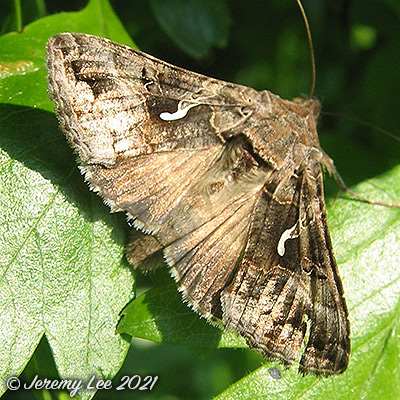
 |
|
Scientific Classifications explained » Amphibians » Ants » Aphids » Bees » Beetles » Birds » Bugs » Butterflies » Caterpillars » Damselflies » Dragonflies » Earwigs » Flies » Frog/Leafhoppers » Fungi » Galls » Grasshoppers » Harvestmen » Hoverflies » Lacewings » Ladybirds » Leaf Mines » Lichens » Mammals » Millipedes » Mosses » Moths » Sawflies » Slugs » Snails » Spiders » Trees & Shrubs » Wasps » Wild Flowers » Woodlice » Postboxes |
UK Nature > Moths > Autographa gamma

Scientific Name: Autographa gamma Common Name: Silver Y Autographa gamma, more commonly known as the Silver Y, is a migratory moth of the family Noctuidae, which is named for the silvery Y-shaped mark on each of its forewings. The Silver Y is a medium-sized moth with a wingspan of 30 to 45 mm. The wings are intricately patterned with various shades of brown and grey providing excellent camouflage. In the centre of each forewing there is a silver-coloured mark shaped like a letter Y or a Greek letter Gamma. It occurs in a wide variety of habitats, particularly open areas. It regularly visits gardens to take nectar from the flowers. Silver Y moths can produce two or three generations in a year with a fourth generation when conditions are particularly good. The eggs are laid on the upper or lower surface of leaves. They are whitish in colour and hemispherical in shape with deep ribbing. They hatch after three to four days (longer in cool conditions). Widespread and common throughout the UK. |
|

https://www.uknature.co.uk is a website dedicated to showing the immense diversity of UK nature and wildlife. Our vast range of habitats, from lowland arable to snow covered mountains, from storm-ravaged coastlines to peaceful inland freshwater lakes and rivers, from dry, sandy heaths to deciduous and coniferous forests, all these habitats contribute to the abundance of UK nature. We have wild birds in huge numbers either residing or visiting our shores (597 recorded species as at July 2013) and we must also not forget the humble back garden with its grass lawns, flower beds filled with nectar rich flowers, shrubs and trees, all designed to attract huge numbers of insects such as bees, moths, butterflies and hoverflies; and finally the small ponds which provide safe havens for frogs, toads, newts and even slow worms and grass snakes. www.uknature.co.uk is the showcase for my personal passion, photographing uknature in all its glory. I sincerely hope you all enjoy the fruits of my labours. This site and all images contained therein is © Jeremy Lee 2004 - 2025. All Rights Reserved. Site design by Jeremy Lee. Site development & IT Support by Stuart Lee. |